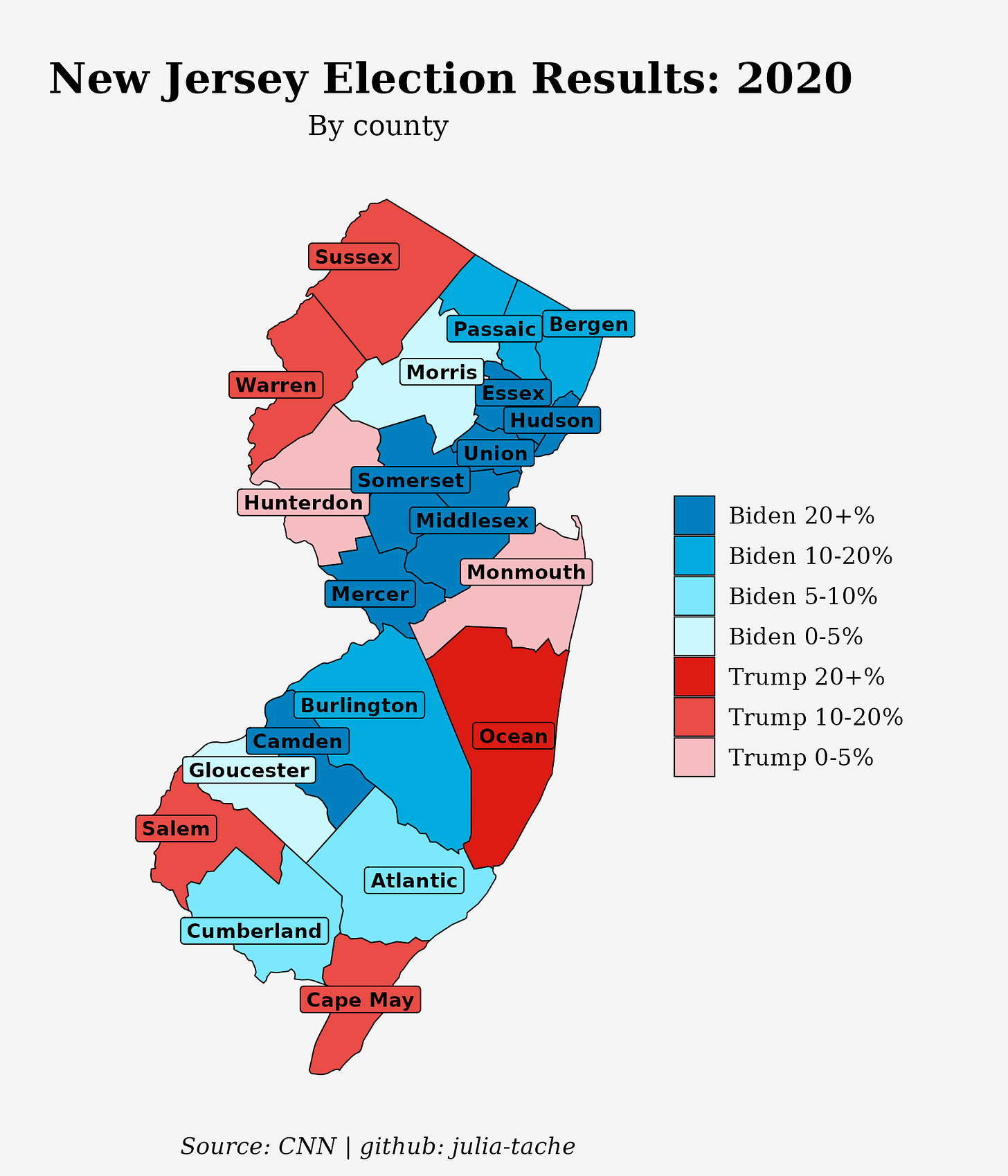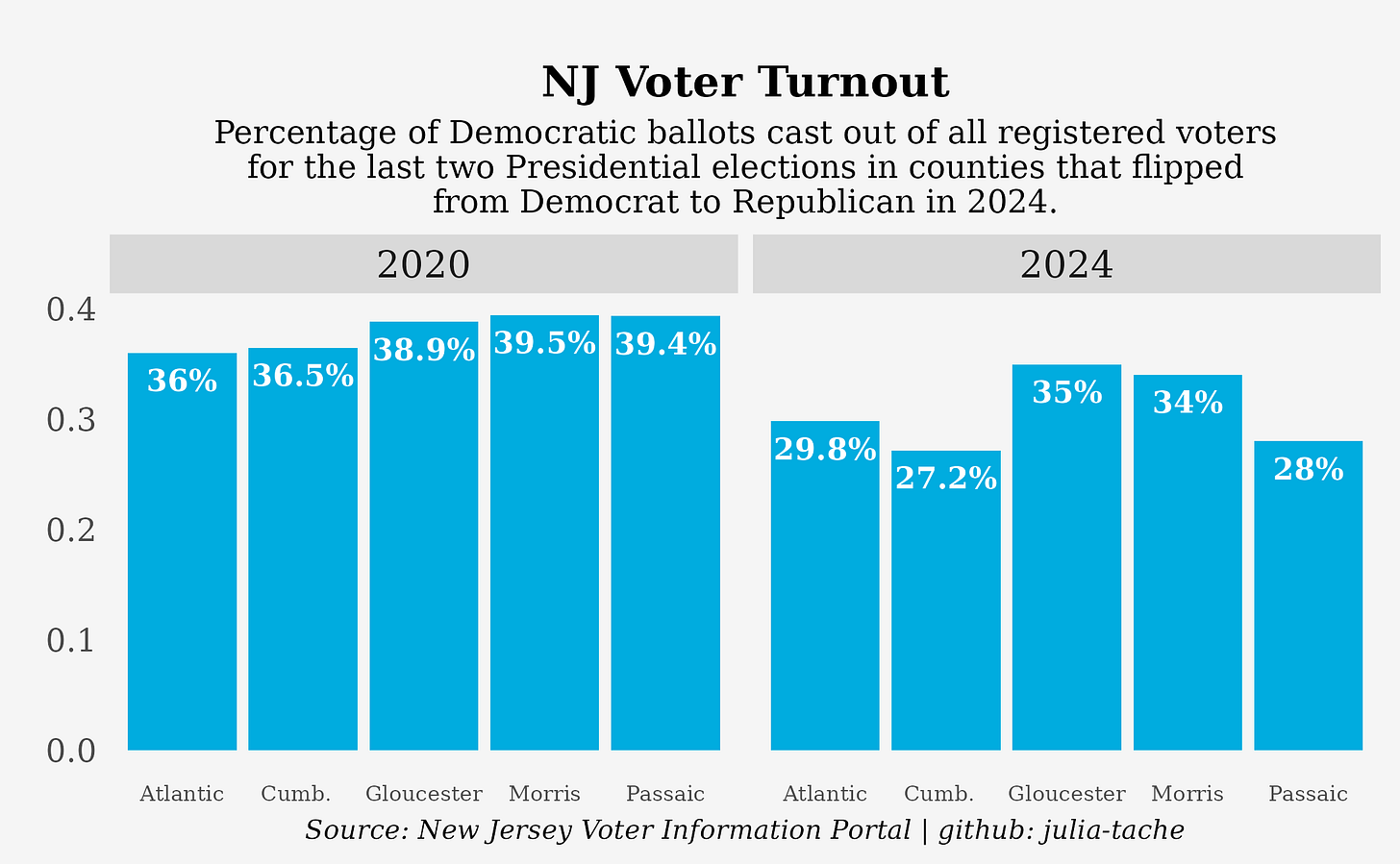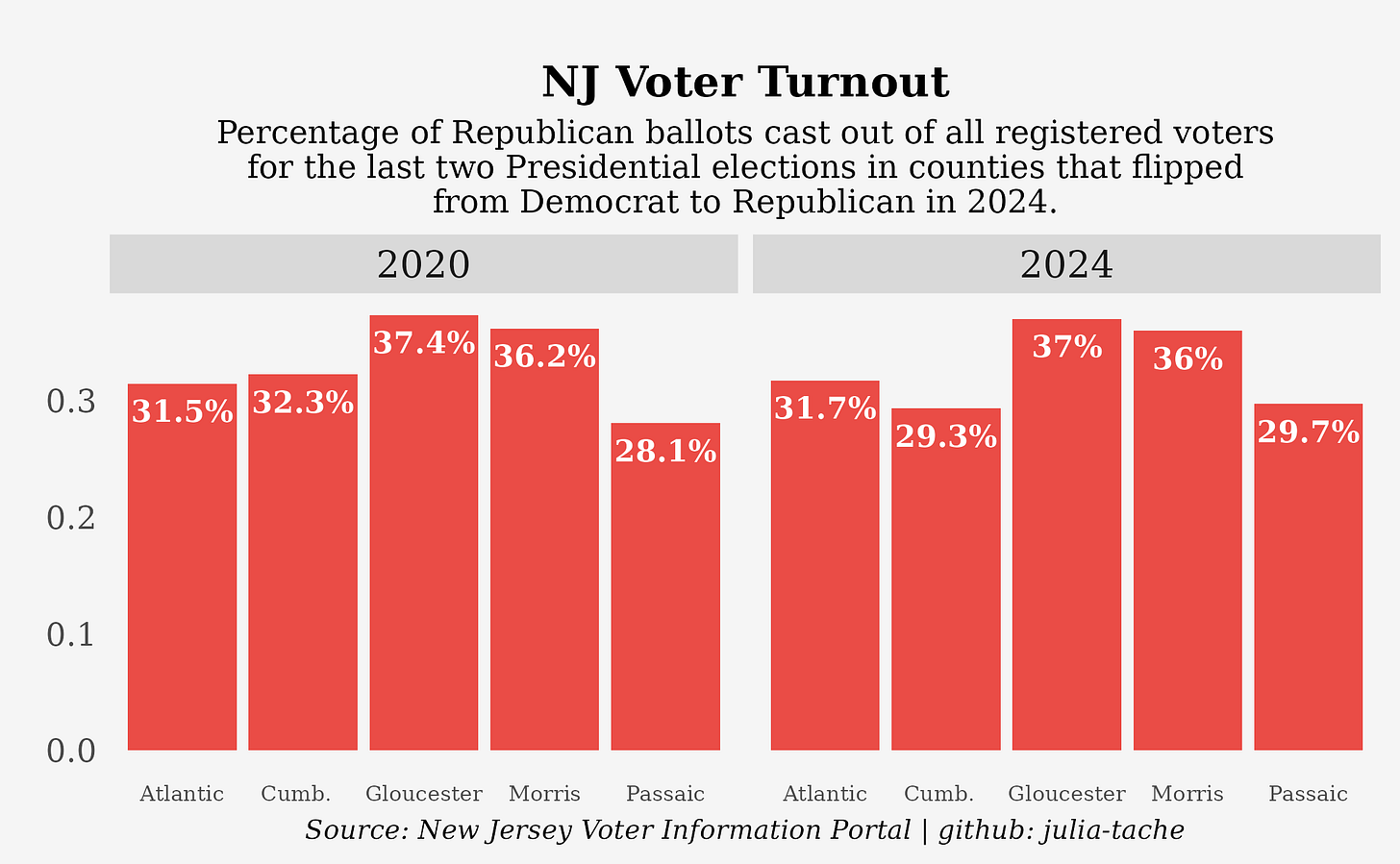New Jersey 2020 vs. 2024: What Happened?
Hello, it’s been a minute. Ending the year with an analysis of election results in my home state. Thank you for reading and enjoying my data viz, wishing you a 2025 with 0 ERROR messages <3 xx
Every election is a chance for professional pundits and armchair statisticians (me) to animatedly discuss results and pin down where campaigns were successful and where they fell short. Debates surrounding why and how Vice President Kamala Harris lost the presidential race in November have been intense, contentious, and ongoing.
Of course, there is never a single reason why a campaign fails, but one thing seems certain on the mountain of election discourse: low turnout negatively affected Harris’ chance of winning. Despite super close polling numbers up until November 5, the reelection of soon-to-be President Donald Trump still caught many off guard. According to Ballotpedia, Trump outperformed his 2020 margins in every single state.
The state with the second largest swing toward Trump was none other than New Jersey, following New York. Jersey is generally regarded as a solidly blue state, in spite of the fact that current governor Phil Murphy narrowly won his reelection in 2021 against Republican Jack Ciattarelli, or the fact that the previous two-term governor was a Republican. While Harris still won NJ, the slim margins of 2024 may indicate a weakening of support from the state’s Democratic base.
Close Calls
President Joe Biden won New Jersey by a whopping 15.8% in 2020. Harris, on the other hand, won by only 5.9% in 2024. This was the lowest margin a Democrat has won New Jersey since 1992 when former President Bill Clinton inched over the finish line with just under 3% of the vote.
The map of 2020 election results shows that a majority of New Jersey’s 21 counties went for Biden. Especially in north and central Jersey, some counties reported Biden leading by over 20%. Despite the fact that Atlantic, Salem, Cumberland, Cape May, and parts of Gloucester and Ocean Counties are represented by a Republican in Congress, Representative Jeff Van Drew, three of those counties went for Biden.
Counties with strong leads for Trump (Warren, Hunterdon, and portions of Sussex and Monmouth Counties) are represented by New Jersey’s other two Republican Congress members, Chris Smith and Thomas Kean, Jr. Historically, those counties tend to be the most red, so Trump’s success is no surprise there.
In 2024, Republican leads intensified in Sussex, Warren, and Hunterdon, with Trump securing an over 20-point lead in Sussex and Warren counties over Harris. She won nine counties only, enough to carry her lead in the state (Bergen, Essex, Hudson, and Union counties are especially population-dense given their proximity to New York City and their larger urban and concentrated suburban areas).
Five out of twenty-one counties “flipped” from Democrat to Republican in 2024: Atlantic, Cumberland, Gloucester, Morris, and Passaic. Atlantic, Cumberland, and Gloucester are all southern counties that had leads for Biden under 10% in 2020, with Gloucester having the slimmest margin at 2%. Demographically, Atlantic, Cumberland, and Passaic counties have some of the lowest median household incomes in the state ($91,891, $76,819 and $97,267), while Morris has the highest ($163,598). Gloucester is close to the state average of $119,240 ($121,675).
Across the state, turnout fell from 71.3% to 64.3%. All three southern, more “conservative” counties that “flipped” also saw lower voter turnout overall and slightly favored Trump by less than 5% in 2024. In Cumberland, where Trump won by 3.7%, turnout dropped by over 12% from 69.7% in 2020 to 57.6% in 2024.
In Morris County, nestled in between the eastern and western counties of north Jersey, both Biden and Trump won by under 5% in 2020 and 2024. Morris could be considered a “swing” county, with half of its area represented by Kean and the other by Democratic Representative Mikie Sherrill. Gloucester, similarly, is split between districts represented by a Democrat and a Republican.
Passaic County had the most striking difference. In 2020, 57.5% voted for Biden, while 49.6% voted for Trump in 2024 (Jill Stein received her largest share of votes in the county with 2.2% of the vote). Trump won by only about 3%, but the results are still noteworthy for a county that has gone blue in every presidential election since 1992.
What the Flip?
Record early voting that favored Democrats falsely indicated that the momentum would continue into Election Day. As stated above, New Jersey voter turnout in 2024 decreased by 7% compared to 2020. 300,000 less people cast ballots in 2024 compared to 2020 (4.6 billion vs. 4.3 billion), and far fewer ballots were invalidated this year.
A lower percentage of ballots cast went toward the Democratic presidential candidate in 2024 compared to 2020 in the five “flipped” counties (because voters registered with any party are able to vote for any candidate in general elections, I calculated these percentages by dividing votes cast by total registered voters as opposed to voters registered as Democrats or Republicans).
Between 36% and 39.4% of eligible voters voted for Biden in 2020 in these counties, but all saw decreases in Democratic voter turnout in 2024, most significantly in Cumberland and Passaic counties. In Passaic, the once Democrat stronghold, only 28% of registered voters voted for Harris.
As a percentage of all registered voters, Republican turnout stayed relatively constant in each of the five “flipped” counties. The share of voters who went for Trump increased by 1.6% in Passaic county, from 28.1% to 29.7%. Cumberland Republican voter turnout fell by around 3%, but this was not enough to make up for the over 9% drop in Democratic ballots.
What These Five Counties Could Tell Us
As many have already pointed out, 2020 may have been an outlier year for high voter turnout in part due to the abundance of mail-in ballots sent during the COVID-19 pandemic. More than 90% of voters in New Jersey voted by mail, and every registered voter in the state received a ballot.
The ease of voting in 2020 sharply contrasted with the difficulty and frustration of this year’s experience at the polls. New equipment adopted across the state and insufficient voting machines in some counties lead to confusion and delays, with some reporting wait times of over ninety minutes at polling places.
2020 also saw a boom in voter registration. On Election Day, there were 667,000 more registered voters than in 2016. In 2024, there were only 275,402 more voters than in 2020. Out of the roughly 38,000 voters who registered in September of 2024, most did not declare a party affiliation, but the number of newly registered Republicans was twice that of Democrats (8,138 vs. 4,533).
On Election Day 2020, out of 6.5 million registered voters, 2.5 million were registered as Democrats and 1.4 million were registered as Republicans. Out of 6.7 million voters in 2024, the number of registered Democrats was relatively the same, but 1.6 million voters were registered as Republicans. While the share of people who voted Republican over all eligible voters was relatively unchanged between the two elections (around 29%), it’s worth pointing out the increase in registered Republicans by almost 200,000 people.
New Jersey voters were simply not mobilized to vote for the Democratic presidential candidate this race in the same way they had been in the past. Although there were some state Dem wins his year, including Andy Kim’s election to the Senate seat previously held by Bob Menendez, the events of the last few cycles have been nothing short of humbling throughout New Jersey’s “big tent.” Activist Sue Altman’s attempt to take back District 7, which Democrat Tom Malinowski lost to Kean in 2022, was unsuccessful. Longtime Democratic State Senator Steve Sweeney was unseated by Republican Ed Durr in 2021 in one of the biggest upsets that year.
Governor Murphy referred to 2024 as a “sobering moment” yet not “just an aberration” in a news press conference. Many pundits have chalked this year’s results up to a “right wing shift” among New Jersey voters. Some have made the case that Republicans are successfully making inroads with minority communities, evidenced by Trump’s share of votes in heavily Latino areas (Atlantic, Cumberland, and Passaic counties are also among some of the most diverse in the state). However, what the five counties who swung to Trump this year could tell us is that maybe the great swell of Republican voters coming in droves to take over the state is overstated. Instead, what appears to have happened is that the Democratic base failed to be as ignited as it had been in previous elections.
Trump may have gained nearly 85,000 votes in 2024, but Harris lost almost 400,000 votes compared to Biden. A true surge in right-wing sentiment would have likely motivated voters to throw their support behind the Republican candidate. Instead, it seems that many people opted this year to simply not vote for either presidential nominee. The sample of “flipped” counties, though small, all have widely varying demographics and population densities, suggesting that Trump’s appeal and Harris’ loss in support crossed a variety of lines.
Another omission from much of mainstream analysis is the impact of the war in Gaza and the ongoing humanitarian crisis. Passaic County, in particular the city of Paterson, is home to one of the largest Palestinian populations in the country. New Jersey’s Uncommitted Campaign, a protest against violence and inaction, received 9% of votes in the primary. The war and how it has been addressed does not completely explain reluctance over voting Democrat this year, but it could have played a major role for some erstwhile Democratic voters.
Harris’ explicit strategy targeting Republican voters by emphasizing support from figures like former Representative Liz Cheney may have also influenced the outcome of the election. It seems that this was not only ineffective, but also could have backfired and made Republican candidates less likely to water down their messages more appealing to certain voters. The question that remains is what will Democratic political operatives learn from this election– will they continue to try to tailor themselves to be more Republican-friendly, or will they try to take steps to win Democratic voters back?
What’s Next for NJ?
In 2025, New Jerseyans will be electing a new governor. Candidates have already stumped on issues important to voters in the state, such as high cost of living and property taxes. While foreign policy may play less of a role in voter’s decision-making at the state level, the shadow of growing conflict in the Middle East looms over every prominent member of the Democratic party.
Next year’s primaries will not only be another game of “will Republican candidates fit or reject Trump’s mold?”, but also a test for New Jersey Democrats fearing a continued loss of steam. This may have profound implications on whether or not gubernatorial candidates will double-down or renege on any progressive bonafides they may have depending on what they see as “winnable.”
New Jersey may not be a battleground state, but these observable trends have sounded alarm bells for Democrats at the national level. What is clear is that whatever message the party is trying to send – whether it’s focusing on climate achievements or supporting unions or reining in corporate power – is not effectively coming through, and that should be deeply concerning in a state that should be safely blue. In terms of economic issues, Trump supporters in New Jersey were more likely to report concern over housing, grocery, gas, and healthcare costs.
After a year of political scandals involving New Jersey Democrats, from accusations of nepotism to high-profile indictments and corruption, perhaps it is unsurprising that voters in the state are feeling reasonably disaffected. NJ Dems will have their work cut out for them to rebuild trust with their constituents amid a nationally conservative environment this next election season.








